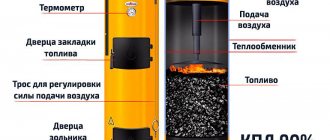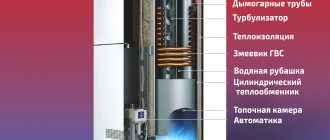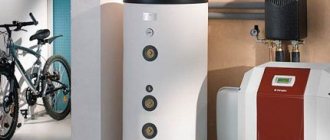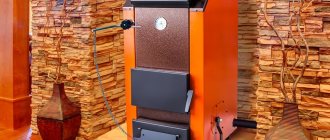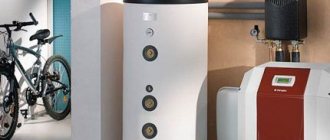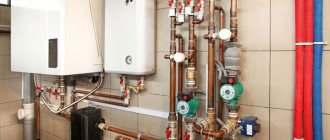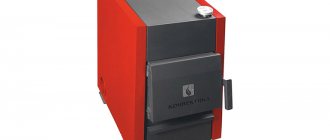The best boilers for heating a private house of 150 sq.m. according to user reviews: summary technical characteristics of boilers with prices for them in online stores in your city.
| Number | Name | Rating |
| Combination boilers Teplodar for 150 sq.m. | ||
| 1 | Teplodar Cooper OVK 18 | |
| 2 | Teplodar Kupper OK 9 | |
| 3 | Teplodar Kupper OK 20 | |
| Liquid fuel boilers Kiturami for 150 sq.m. | ||
| 1 | Kiturami Turbo 13R | |
| 2 | Kiturami Turbo 17R | |
| 3 | Kiturami TURBO HI FIN 17 | |
| Liquid fuel boilers Navien for 150 sq.m. | ||
| 1 | Navien LFA 13K | |
| Solid fuel boilers NMK for 150 sq.m. | ||
| 1 | NMK Sibir-Gefest KVO 15 TE | |
| Solid fuel boilers ZOTA for 150 sq.m. | ||
| 1 | ZOTA Topol M 20 | |
| Solid fuel boilers Protherm for 150 sq.m. | ||
| 1 | Protherm Beaver 20 DLO | |
| Lemax solid fuel boilers for 150 sq.m. | ||
| 1 | Lemax Forward-20 | |
| 2 | Lemax Forward-16 | |
| 3 | Lemax Forward-12.5 | |
| Gas boilers Conord for 150 sq.m. | ||
| 1 | Conord KSts-G-16S | |
| Oasis gas boilers for 150 sq.m. | ||
| 1 | Oasis RT-20 | |
| 2 | Oasis BM-20 | |
| 3 | Oasis BM-18 | |
| 4 | Oasis RT-16 | |
| 5 | Oasis BM-16 | |
| Lemax gas boilers for 150 sq.m. | ||
| 1 | Lemax Patriot-20 | |
| 2 | Lemax Wise 16 | |
| 3 | Lemax Premium-12.5N | |
| 4 | Lemax Premium-20 | |
| 5 | Lemax Premium-12.5 | |
| 6 | Lemax Premium-10N | |
| 7 | Lemax Patriot-16 | |
| 8 | Lemax Premium-16N | |
| 9 | Lemax Premium-16 | |
| 10 | Lemax Premium-10 | |
| Gas boilers Rostovgazoapparat for 150 sq.m. | ||
| 1 | Rostovgazoapparat AOGV 11.6 | |
| Leberg gas boilers for 150 sq.m. | ||
| 1 | Leberg Flamme 24 ASD | |
| Navien gas boilers for 150 sq.m. | ||
| 1 | Navien DELUXE 13K | |
| Bosch gas boilers for 150 sq.m. | ||
| 1 | Bosch Gaz 6000 W WBN 6000- 12 C | |
| 2 | Bosch Gaz 6000 W WBN 6000-18 C | |
| Gas boilers MORA-TOP for 150 sq.m. | ||
| 1 | MORA-TOP Meteor Plus PK18SK | |
| 2 | MORA-TOP Meteor Plus PK18ST | |
| 3 | MORA-TOP Meteor PK18ST | |
| 4 | MORA-TOP SA 20 | |
| 5 | MORA-TOP SA 20 G | |
| Protherm gas boilers for 150 sq.m. | ||
| 1 | Protherm Wolf 16 KSO | |
| Electric boilers Protherm for 150 sq.m. | ||
| 1 | Protherm Skat 14 KR 13 | |
| 2 | Protherm Skat 9 KR 13 | |
| 3 | Protherm Skat 12 KR 13 | |
| Electric boilers MORA-TOP for 150 sq.m. | ||
| 1 | MORA-TOP Electra Comfort 15K | |
| Electric boilers EVAN for 150 sq.m. | ||
| 1 | EVAN EXPERT 9 | |
Combination boilers Teplodar for 150 sq.m.
Teplodar Cooper OVK 18
- Power, kWt:
18 - Number of circuits:
1 - Type:
floor - Rating:
4.5
Advantages:
- price
- burns smoothly
Flaws:
- There's a lot of soot from wet wood
- burns out quickly
Teplodar Kupper OK 9
- Power, kWt:
9 - Number of circuits:
1 - Type:
floor - Rating:
3.0
Advantages:
- small size
- presence of heating element
- thermal insulation
Flaws:
- small firebox
- noisy
Teplodar Kupper OK 20
- Power, kWt:
20 - Number of circuits:
1 - Type:
floor - Rating:
3.5
Advantages:
- multifunctional
- reliable
- quality materials
Flaws:
- price without standard burner
- without strapping
- cannot be placed close to the wall
- the boiler must not overheat
Liquid fuel boilers Kiturami for 150 sq.m.
Kiturami Turbo 13R
- Power, kWt:
15.1 - Number of circuits:
2 - Type:
floor - Network phasing:
1 - Rating:
5.0
Advantages:
- price
- compactness
Flaws:
- efficiency is not true
- The chimney supplied with the model is wider in diameter than required
- no official representation
Kiturami Turbo 17R
- Power, kWt:
19.8 - Number of circuits:
2 - Type:
floor - Network phasing:
1 - Rating:
4.0
Advantages:
- price
- automatic temperature control with remote control
- gear pump
Flaws:
- noise
- poor implementation of hot water supply
- rapid breakdown of all sensors
- injectors often clog
- runs only on diesel engines not lower than Euro 5
Kiturami TURBO HI FIN 17
- Power, kWt:
19.8 - Number of circuits:
2 - Type:
floor - Network phasing:
1 - Rating:
3.0
Advantages:
- independent work due to automation
- no need to constantly heat
Flaws:
- high cost of repairs
- picky about fuel quality and correct settings
What are floor-standing gas boilers?
Modern gas floor-standing boilers have an excellent design, compact size and operate almost silently, so they can be installed in any room in a private home that meets the requirements.
A gas floor-standing boiler is a stationary, single-circuit or double-circuit, most often atmospheric and energy-independent, central element of the heating system, responsible for the generation of thermal energy. In most cases, floor-standing models are not equipped with a circulation pump, air vent, safety valve and other heating system elements found in wall-mounted models.
Floor-standing models are more versatile, less dependent on weather conditions, gas and coolant quality, and according to operating practice and service call statistics, they are more reliable and problem-free. Like wall-mounted ones, they can operate on natural and liquefied (ballooned) gas; to switch to the latter, just change the burner. Prices for the most budget gas floor-standing boilers start from 12-13 thousand rubles.
Design and principle of operation
The device using the example of a floor-standing single-circuit Vaillant atmoVIT VK INT 164/1-5.
The design and principle of operation may differ slightly from model to model, but in most cases modern models operate on the same principle as classic old-style boilers, only the materials, manufacturing technologies and design efficiency have changed:
- Natural gas is supplied from the gas main through the burner nozzles into the combustion chamber.
- Using piezo ignition (by pressing a button in non-volatile boilers) or electric ignition (automatically in energy-dependent boilers), the pilot light is ignited, igniting the main burner.
- Upon reaching the set coolant temperature, the gas supply stops and the gas burner goes out, the igniter continues to burn.
- When the temperature drops, the gas supply is resumed and the igniter ignites the main burner again.
- The walls of the combustion chamber are a heat exchanger within which the coolant circulates. The coolant distributes the accumulated thermal energy throughout the heating system, releasing heat through radiators, after which it is returned back to the boiler.
- The oxygen needed to burn the gas is taken in through holes in the bottom of the boiler. Combustion products are discharged through the chimney through natural draft.
This is how classic non-volatile atmospheric (with an open combustion chamber and vertical chimney) models work. More expensive floor-standing gas boilers also come with a closed combustion chamber, they are also turbocharged. Air for gas combustion is forced into them using a turbine, which increases combustion efficiency. In this case, combustion products are discharged into them through a coaxial (side) chimney, as in most wall-mounted models, which greatly simplifies installation and room requirements. We will further analyze this selection criterion further.
Separately, it is worth noting parapet boilers, which buyers mistakenly often call chimneyless. They are neither wall-mounted nor floor-mounted and are equipped with a coaxial chimney, which is integral with the boiler. We have already written in the corresponding article why this option should not be considered.
Is it worth considering parapet gas boilers for heating a private home?
Liquid fuel boilers Navien for 150 sq.m.
Navien LFA 13K
- Power, kWt:
13 - Number of circuits:
2 - Type:
floor - Network phasing:
1 - Rating:
5.0
Advantages:
- quiet
- price
Flaws:
- high cost of solariums
- coaxial chimney
- Fuel freezes at -30
- impossibility of independently collecting fuel from depth
- There is no standard connector for connecting to a GSM remote control system
Solid fuel boilers NMK for 150 sq.m.
NMK Sibir-Gefest KVO 15 TE
- Power, kWt:
15 - Number of circuits:
1 - Type:
floor - Rating:
3.0
Advantages:
- huge firebox in volume and length
- convenient loading
- compact
- quickly gains temperature
- chimney versatility
Flaws:
- quality
- not convenient to clean
Lemax solid fuel boilers for 150 sq.m.
Lemax Forward-20
- Power, kWt:
20 - Number of circuits:
1 - Type:
floor - Rating:
5.0
Advantages:
- Possibility to connect to a water heating system with natural circulation
- steel thickness
- vertical loading
- silent
- does not depend on electricity
- high efficiency
Flaws:
- vertical loading height
Lemax Forward-16
- Power, kWt:
17 - Number of circuits:
1 - Type:
floor - Rating:
5.0
Advantages:
- price
- energy independence
- convenient loading door
Flaws:
- chimney diameter
Lemax Forward-12.5
- Power, kWt:
13 - Number of circuits:
1 - Type:
floor - Rating:
5.0
Advantages:
- energy dependence
- silent
- powerful
- price
- doesn't heat up outside
Flaws:
- inconvenient to clean
- vertical loading
- small firebox
- it is impossible to regulate smoldering
Advantages and disadvantages of gas boilers with a pump
The advantages of gas boilers with a pump include:
- metal parts of the system give off heat well;
- it is possible to change temperature conditions;
- Provides quick heating of heating radiators.
The only disadvantages of such a boiler include dependence on electricity and the need to bear costs for it. If the power goes out, the unit will not be able to work. Therefore, it is only suitable for use in regions where electricity is rarely cut off.
Oasis gas boilers for 150 sq.m.
Oasis RT-20
- Power, kWt:
20 - Number of circuits:
2 - Type:
wall - Network phasing:
1 - Circulation pump:
yes - Expansion tank:
yes - Rating:
5.0
Advantages:
- electronic control
- powerful
- safe
- reliable
Flaws:
- few functions
Oasis BM-20
- Power, kWt:
20 - Number of circuits:
2 - Type:
wall - Network phasing:
1 - Circulation pump:
yes - Expansion tank:
yes - Rating:
5.0
Advantages:
- price
- simplicity
- bimetallic heat exchanger
Flaws:
- No
Oasis BM-18
- Power, kWt:
18 - Number of circuits:
2 - Type:
wall - Network phasing:
1 - Circulation pump:
yes - Expansion tank:
yes - Rating:
5.0
Advantages:
- price
- Ease of use
- safety
- compact
- frost protection
Flaws:
- No
Oasis RT-16
- Power, kWt:
16 - Number of circuits:
2 - Type:
wall - Network phasing:
1 - Circulation pump:
yes - Expansion tank:
yes - Rating:
5.0
Advantages:
- price
- electronic control
- safety
- compact
- powerful
- silent
Flaws:
- No
Oasis BM-16
- Power, kWt:
16 - Number of circuits:
2 - Type:
wall - Network phasing:
1 - Circulation pump:
yes - Expansion tank:
yes - Rating:
4.0
Advantages:
- price
- support for heated floors
- availability of display
- protective functions
- autodiagnostics
- economical
- silent
- presence of thermometer and pressure gauge
- auto ignition
Flaws:
- noisy
- loud start
- common mistakes
- quick failure
Lemax gas boilers for 150 sq.m.
Lemax Patriot-20
- Power, kWt:
20 - Number of circuits:
1 - Type:
parapet - Circulation pump:
no - Expansion tank:
no - Rating:
5.0
Advantages:
- energy dependence
- price
- economical
- simplicity
- no need for a chimney
- silent
- closed chamber
- overheat protection
Flaws:
- No
Lemax Wise 16
- Power, kWt:
16 - Number of circuits:
1 - Type:
floor - Network phasing:
1 - Circulation pump:
no - Expansion tank:
no - Rating:
5.0
Advantages:
- powerful
- price
- protection of the heat exchanger from corrosion
- thick metal boiler
- ability to work under voltage surges
Flaws:
- No
Lemax Premium-12.5N
- Power, kWt:
12.5 - Number of circuits:
1 - Type:
floor - Circulation pump:
no - Expansion tank:
no - Rating:
5.0
Lemax Premium-20
- Power, kWt:
20 - Number of circuits:
1 - Type:
floor - Circulation pump:
no - Expansion tank:
no - Rating:
5.0
Advantages:
- reliability
- high efficiency
- powerful
- silent
- easy to clean
- does not depend on electricity
- price
- build quality
Flaws:
- No
Lemax Premium-12.5
- Power, kWt:
12.5 - Number of circuits:
1 - Type:
floor - Circulation pump:
no - Expansion tank:
no - Rating:
5.0
Advantages:
- powerful
- easy controls
- easy to clean
- blow-out protection
Flaws:
- No
Lemax Premium-10N
- Power, kWt:
10 - Number of circuits:
1 - Type:
floor - Circulation pump:
no - Expansion tank:
no - Rating:
4.0
Lemax Patriot-16
- Power, kWt:
16 - Number of circuits:
1 - Type:
parapet - Circulation pump:
no - Expansion tank:
no - Rating:
4.5
Advantages:
- energy independence
- low gas consumption
- price
- ease of installation and configuration
Flaws:
- No
Lemax Premium-16N
- Power, kWt:
16 - Number of circuits:
1 - Type:
floor - Circulation pump:
no - Expansion tank:
no - Rating:
4.5
Lemax Premium-16
- Power, kWt:
16 - Number of circuits:
1 - Type:
floor - Circulation pump:
no - Expansion tank:
no - Rating:
4.5
Advantages:
- price
- silent
- protection system
- ease of cleaning the boiler
- ease of use
Flaws:
- No
Lemax Premium-10
- Power, kWt:
10 - Number of circuits:
1 - Type:
floor - Circulation pump:
no - Expansion tank:
no - Rating:
4.5
Advantages:
- price
- compact dimensions
- good efficiency, economical
- silent
- modern security system
- the boiler is easy to clean
- powerful
Flaws:
- custom reviews
- Periodically you need to monitor the condition of consumable parts
Gas, solid fuel, liquid fuel or electric
In total, depending on the fuel used, there are four main types of domestic boilers:
- Gas (natural gas, liquefied gas). The most common and high-tech, they account for more than 60% of demand. In practice, heating with a gas boiler is one of the cheapest options, and at the same time the least labor-intensive: you don’t need to think about storing fuel, and many, even budget, boilers can operate autonomously, without the slightest human intervention, for days and even weeks. Modern gas models have an average efficiency of 88-94%, multifunctional automation, even the ability to connect a room thermostat, and the cost of good budget models from well-known manufacturers is in the range of 19-30 thousand rubles (Buderus, BAXI, Protherm, Lemax). The only difficulty is the long bureaucratic process of obtaining permission to install a gas boiler.
Cutaway view of a modern Teplodar Kupper coal boiler. - Solid fuel (firewood, coal and charcoal, peat, pellets). Solid fuel boilers are still an excellent choice in non-gasified areas of Russia, or if you have access to solid fuel at lower prices. The well-known and main disadvantage of solid fuel models is the need for constant participation in the combustion process, as well as the need to organize a place for storing fuel, its preparation and transportation. The design of modern models allows you to increase the burning time of one load to 4-6 hours if it is firewood and up to 10-15 hours if coal is used. However, the need for frequent refilling of fuel still remains a significant drawback. Fortunately, there are also long-burning models, up to 7 days, or pellet boilers with automatic feeding, but the cost of such boiler units starts from 60-90 thousand rubles.
Organization of a boiler room with a tank for storing liquid fuel. - Liquid fuel (waste oil, diesel, fuel oil, kerosene). Liquid fuel boilers are an excellent alternative to solid fuel boilers. Their advantages and disadvantages are as close as possible to gas models - and this is not surprising, because they differ only in burners. Diesel boilers and boiler units operating during exhaust are completely autonomous (you only need to replenish the tank in which the fuel is stored), sometimes have a higher efficiency, and when operating correctly, completely burn the fuel, emitting a minimum of harmful substances. If you try and find a source of fuel for a symbolic price (using equipment from agricultural enterprises, auto repair shops, bus or truck fleets), then operating costs may be lower than with gas heating. Despite not having such a large selection, there are clear leaders in the diesel boiler market - Navien and Kiturami, and we recommend that you pay attention to them when choosing.
Compact heating element Proterm. - Electrical . Electric boilers are ideal from the point of view of operating comfort, efficiency and functionality, but operating costs when using them are the highest. Heating a house with an area of 150 m2 may require from 10 to 14 thousand rubles per month, even taking into account reduced night rates. With an unlimited budget, this is an ideal option even for a house with an area of 150 m2, however, from an economic point of view, electric boilers are justified only when heating small private houses of up to 60-80 square meters.
Efficiency and selection criteria for energy-saving electric heating boilers
To summarize, if there is a gas main near your house, you should choose a gas boiler without hesitation. In the absence of a gas main, the best option is a solid fuel or liquid fuel boiler; the choice depends on the requirements for autonomy, the availability of a particular type of fuel, and personal preferences.
Leberg gas boilers for 150 sq.m.
Leberg Flamme 24 ASD
- Power, kWt:
20 - Number of circuits:
2 - Type:
wall - Network phasing:
1 - Circulation pump:
yes - Expansion tank:
yes - Rating:
4.5
Advantages:
- easy installation
- brass heat sink
- fan at the top
- price
- build quality
- auto diagnostic system
- double-circuit
- high efficiency
Flaws:
- weight
- frequent breakdowns
Bosch gas boilers for 150 sq.m.
Bosch Gaz 6000 W WBN 6000- 12 C
- Power, kWt:
12 - Number of circuits:
2 - Type:
wall - Network phasing:
1 - Circulation pump:
yes - Expansion tank:
yes - Rating:
5.0
Advantages:
- silent
- economical
- compact
- easy to disassemble
Flaws:
- noisy
Bosch Gaz 6000 W WBN 6000-18 C
- Power, kWt:
18 - Number of circuits:
2 - Type:
wall - Network phasing:
1 - Circulation pump:
yes - Expansion tank:
yes - Rating:
4.5
Advantages:
- silent
- compact
- economical
- build quality
Flaws:
- complex initial setting of hot water and heating power
- thinks for a long time when switching from heating to hot water
- difficult to buy parts for repairs
The best high-power gas boilers
In apartment buildings, hotels and large (from 400 to 600 sq. m.) cottages, when there is a need to heat not only the indoor space, but also a swimming pool, gym, winter garden and other heat-intensive objects, it is most rational to install a heating system based on several single-circuit or double-circuit gas boilers with a power of at least 50-60 kW. When choosing, special attention should be paid to the range of automatic settings, the capabilities of control systems and timely adjustment of the operating mode.
Gas boilers MORA-TOP for 150 sq.m.
MORA-TOP Meteor Plus PK18SK
- Power, kWt:
18.9 - Number of circuits:
1 - Type:
wall - Network phasing:
1 - Circulation pump:
yes - Expansion tank:
yes - Rating:
5.0
Advantages:
- autodiagnostics
- gas control
- overheat protection
- Anti-freeze mode
- pump blocking protection
- suitable for single-phase network
- price
- silent
Flaws:
- No
MORA-TOP Meteor Plus PK18ST
- Power, kWt:
18.6 - Number of circuits:
1 - Type:
wall - Network phasing:
1 - Circulation pump:
yes - Expansion tank:
yes - Rating:
5.0
Advantages:
- low gas consumption
- easy to maintain
- unpretentious to gas pressure changes
- gas control
- high efficiency
- large expansion tank
- auto ignition
- air vent
- room thermostat
- economical
Flaws:
- No
MORA-TOP Meteor PK18ST
- Power, kWt:
18.6 - Number of circuits:
1 - Type:
wall - Network phasing:
1 - Circulation pump:
yes - Expansion tank:
yes - Rating:
5.0
Advantages:
- overheat protection
- external control connection
- auto ignition
- thermometer
- economical
- price
- thermostat
Flaws:
- No
MORA-TOP SA 20
- Power, kWt:
15 - Number of circuits:
1 - Type:
floor - Network phasing:
1 - Circulation pump:
no - Expansion tank:
no - Rating:
5.0
Advantages:
- price
- efficiency
- gas control
- fast heating
- power indicator
- flame modulation
- open combustion chamber
- atmospheric stainless steel burner
- works properly at low gas pressure
- does not respond to power outages
- summer-winter mode
- convenient pilot burner
Flaws:
- No
MORA-TOP SA 20 G
- Power, kWt:
15 - Number of circuits:
1 - Type:
floor - Circulation pump:
no - Expansion tank:
no - Rating:
5.0
Advantages:
- price
- presence of thermometer and pressure gauge
- presence of a gas burner
- non-volatile
- presence of gas control
- high efficiency
- cast iron anti-corrosion heat exchangers
Flaws:
- No
Which ones are more suitable?
When considering purchasing a gas boiler for heating a private home, which one is better to choose? Surely many people ask this question. So, when purchasing a boiler for a house of 150 m², it is important to consider several factors. Among them:
- Total square footage and length of highways.
- The degree of thermal insulation.
- Diameter and material of walls.
Since units with an open burner do not have a chimney, it is necessary to provide for the effective removal of used gases. In closed chambers there is forced draft.
There are combined models with a special fan that increases air flow. Smoke from the use of blue fuel is discharged into the street through a small hole.
Such boilers do not provide for the organization of a chimney, however, they require careful care and cleaning from contaminants. If they are not maintained, the inlet will become clogged with leaves or other debris, causing the unit to stop functioning.
Each device has its own advantages and disadvantages. However, only options with natural draft are non-volatile units.
Electric boilers Protherm for 150 sq.m.
Protherm Skat 14 KR 13
- Power, kWt:
14 - Number of circuits:
1 - Type:
wall - Network phasing:
3 - Circulation pump:
yes - Expansion tank:
yes - Rating:
5.0
Advantages:
- unpretentiousness
- easy installation
Flaws:
- frequent breakdowns
- expensive repairs
Protherm Skat 9 KR 13
- Power, kWt:
9 - Number of circuits:
1 - Type:
wall - Network phasing:
1.3 - Circulation pump:
yes - Expansion tank:
yes - Rating:
4.0
Advantages:
- presence of a security group
- protection against overheating and pressure drop
- compactness
- build quality
- ease of installation
- ease of operation
Flaws:
- noise
- sensitivity to network changes
- price
- expensive maintenance
Protherm Skat 12 KR 13
- Power, kWt:
12 - Number of circuits:
1 - Type:
wall - Network phasing:
3 - Circulation pump:
yes - Expansion tank:
yes - Rating:
4.5
Advantages:
- silent
- Ease of Management
- compactness
Flaws:
- unreliable
- turns off when operating on 3 phases
Heating automation
Before deciding which boiler to choose for heating a house of 150 square meters, you should also think about what degree of automation of this process you need.
Can you stay at home all the time and add new fuel every 4-6 hours? Then the most ordinary wood-burning boiler of 18-20 kW is quite suitable for you.
When using a buffer tank of 150-200 liters, a boiler of this power will be able to correctly heat the area you need.
If you require longer intervals between fuel fills, then you should consider more automated systems.
As an example, you can use a pellet or coal automated heat generator. Yes, their purchase will cost you 150-200 thousand rubles.
But at the same time, you can add fuel once every 2-3 days (the period depends on the volume of the boiler hopper).
If you use a large coal bunker or a big bag for pellets, you won’t be able to go near the boiler to add fuel for weeks.
Electric boilers MORA-TOP for 150 sq.m.
MORA-TOP Electra Comfort 15K
- Power, kWt:
15 - Number of circuits:
1 - Type:
wall - Network phasing:
3 - Circulation pump:
yes - Expansion tank:
yes - Rating:
5.0
Advantages:
- powerful
- compactness
- overheat protection
- Ease of Management
- built-in thermometer and pressure gauge
- insane
- self-diagnosis system
- floor heating mode
Flaws:
- No
Electric boilers EVAN for 150 sq.m.
EVAN EXPERT 9
- Power, kWt:
9 - Number of circuits:
1 - Type:
wall - Network phasing:
1.3 - Circulation pump:
yes - Expansion tank:
no - Rating:
5.0
Advantages:
- everything in one device
- easy setup
- affordable price
- compactness
- reliability
Flaws:
- noise
- expansion tank is small
How to choose a circulation pump?
To choose the right circulation pump, before visiting the store you should write down the basic data on which the choice will be based:
- area of the heated room;
- characteristics and brand of the heating boiler;
- coolant temperature.
With this data, you can contact the seller of a specialized store, he will help you find a suitable pump.
It is better, of course, to choose a circulation device with a minimum noise level, but they have a power limitation.
The performance of such pumps is not enough to heat large areas. Note! When purchasing a pump with a wet rotor, keep in mind that it must have a special filter that prevents debris from entering the system.
There are also formulas that professionals use to calculate the optimal pump parameters. When choosing a circulation device, it is better to consult a specialist. To install it, you will need to call a service center employee.
